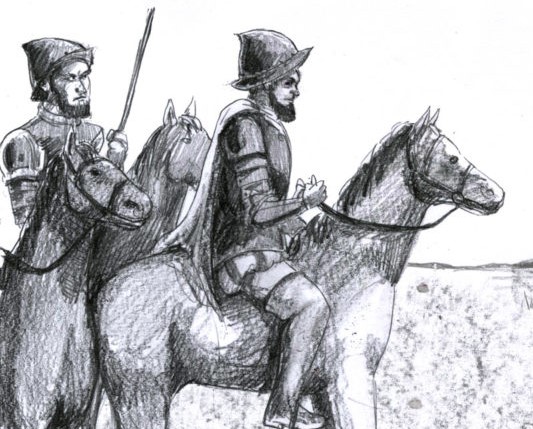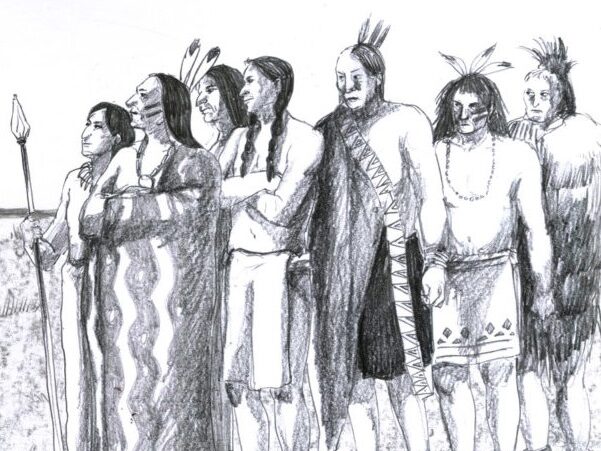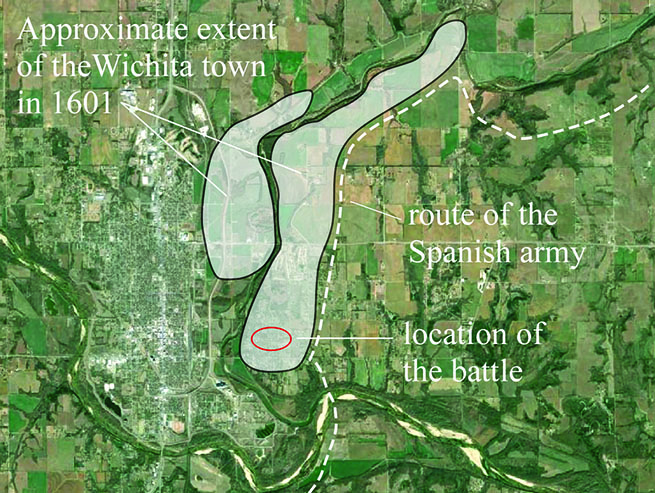
Juan de Oñate
Juan de Oñate, “the last of the conquistadors,” was born around 1550 CE in Zacatecas, New Spain — now Mexico — the son of nobility.
In 1595, the Spanish viceroy in Mexico City appointed Oñate to settle New Mexico. In January 1598 he led soldiers, settlers, families, servants, and missionaries to the proposed territory.

On April 30, 1598, they arrived at New Mexico where he declared the land for Spain.
The disappointed settlers found a cold, dry climate not suitable for growing crops. The Indigenous peoples, brutally treated by the Spaniards, rebelled against the intruders.
In June 1601, Oñate set out from near Santa Fe toward a fabled land to the northeast, Quivira.
Oñate went to find two rebel Spaniards. He also hoped to find the riches of the fabled “Seven Cities of Cibola.”
Along his way Oñate led his troops northeasterly, into plains country. There they encountered large herds of American bison the Spaniards called “monstrous cattle.”
After crossing several rivers, they headed toward the now Oklahoma-Kansas border.
There they met up with a nomadic nation of about 6,000 people they called “Escanjaques.”
Since the Escanjaques were enemies with their neighbors, the Etzanoans, they decided to make up a story. They said the Etzanoans attacked and defeated Spaniards Oñate searched for.
The Escanjaques offered to accompany Oñate and his men to Etzanoa. Oñate tried to discourage them from coming, but they followed the Spaniards anyway.
Finally, the group reached the outskirts of the great settlement. The Spaniards sighted Etzanoa and many inhabitants from their camp above the Arkansas River.
Although the Etzanoans observed the Spanish alongside their enemies, eventually both sides indicated they wanted peace.

The next day the peaceful atmosphere disappeared after Oñate seized several Etzanoans, including a chief, as hostages. Seeing this, the people of Etzanoa fled from their homes to the north.
Meanwhile, Oñate ordered twelve of his men to explore the vast settlement, now abandoned by its inhabitants. They set out to the north and the east and covered about five miles along a river.
With a lack of supplies, wintry weather approaching, and danger of conflict with the Etzanoans, the troops prepared to leave. On their way back to the camp, however, they met a large group of aggressive Escanjaques.

The following day, they began their trip back to New Mexico. They arrived back on November 24, 1601.
There Oñate found the colonists conspired against him while he was away. About two-thirds of the settlers left the colony and reported Oñate’s poor management.
Oñate continued in his role of governor of New Mexico for a decade after his expedition. Later, Oñate ran out of supplies and support. He submitted a letter stating his resigned his position as governor.
Oñate returned to Mexico City and then went to Spain to clear his name.
In June 1626, he died in Spain working as the mining inspector of Spain.
